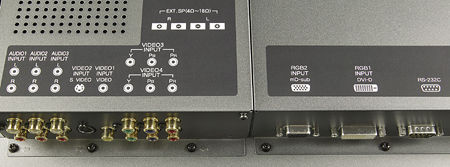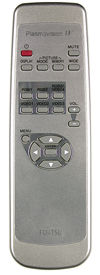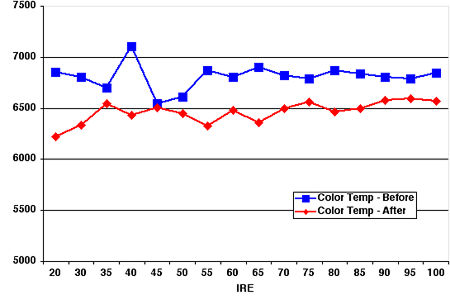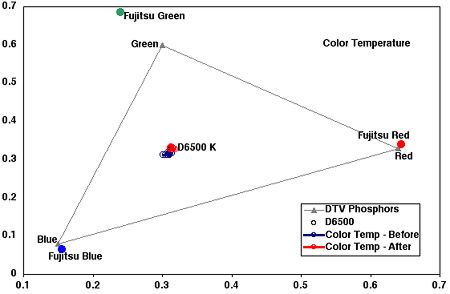Artison Portrait Speaker System, Velodyne DD-12 Subwoofer, and Fujitsu P55XHA30WS Plasma HD Monitor Fujitsu P55XHA30WS Plasma HD Monitor
by Geoffrey Morrison
Just when you thought it was safe to go plasma shopping.
Until recently, all seemed to be stable in the world of plasma. The 42-inch screen was a well-established size. Sure, there were a few 43- and 37-inchers out there, but everyone knew 42 for many reasons (not the least of which is because it's the meaning of life, but that's a different story). There was confusion in the 60s, as you could find 60-, 61-, and 63-inch screens, but at least there was the steady stalwart: 50 inches. Most companies make 50-inchers, as they're a good size and are offered at a saner price than the insane posse of 60s. There was no confusion, but there was also a big difference in screen size between the 50 and any of the 60s. Fujitsu has now filled that gap with the 55-inch P55XHA30WS.

This plasma is not, however, 55 inches wide. Why would I think such a thing? Because the box told me so. It says "55" Wide Plasma Screen." Do they mean "55-inch widescreen plasma," or are they trying to say, "55-inch-wide plasma screen"? I'm confident it's poor translation and not marketing deception, but I measured to be sure. Even with the bezel, the plasma is only 54 inches wide, but the screen measures 55 inches diagonally, which gives the P55XHA30WS a 10 percent leg up in screen diagonal and a whopping 21 percent more screen area than a 50-inch plasma. I'm sure you find this fascinating. I'll move on.
Aesthetically, the P55XHA30WS appears almost identical to the P50XHA10US that I reviewed in the November 2003 issue. At the time, that plasma was quite a looker; in the amazingly fast world of plasma design, though, it has now lost some of its luster. Don't get me wrong, it's still attractive; it just doesn't stand out from the crowd. Thankfully, the P55XHA30WS doesn't have a glossy finish, as many of the new flat panels do. If you don't see why glossy fascias are a bad idea, try watching a glossy-finished display with the lights on. You'll be able to watch yourself watching TV.
The available tabletop stand is beefy—and it's one of the more-attractive stands on the market. Too bad most people will mount this plasma on a wall. On the back panel, you'll find one input each for S-video, composite, RGB, and DVI with HDCP, as well as two component video ins. At the appropriate seating distance, you won't be able to hear the plasma; however, up close, its mechanical whirring is a little louder than a few of the plasmas we've had in recently.
The remote is more attractive than many plasma remotes, mostly due to the chrome plating. OK, so it's not real chrome; it's still shiny. I like shiny. I don't like that the remote isn't backlit, but it has direct input access and dedicated buttons to switch between the different wide modes, picture presets, and picture memories. A word of caution: Only the fine and still picture modes don't float the black level. If that kind of electronic meddling bothers you, keep the plasma in one of these modes.
 First up, I fed the P55XHA30WS our usual barrage of test patterns. For a high-end product, 3:2 pickup was about average. In terms of speed, this process was a mixed bag; but, when the display did figure out how the image should look, it processed it well. For example, in chapter 2 of Armageddon (which is a nonanamorphic 2.35:1 image), the Fujitsu picked up the 3:2 sequence quickly and made the building look perfect. When I expanded the image to fill the width of the screen within the proper aspect ratio, the Fujitsu took a jagged-edge-filled second to correct the image, but it did correct it. In most normal situations, you wouldn't notice this second. Naturally, I figured the results would be similar when I used the third DTS Demo Disc, our torture disc. Here, the P55XHA30WS adjusted the image quickly and created an almost completely artifact-free image. This is impressive for a display, as its performance was almost as good as the best progressive-scan DVD players.
First up, I fed the P55XHA30WS our usual barrage of test patterns. For a high-end product, 3:2 pickup was about average. In terms of speed, this process was a mixed bag; but, when the display did figure out how the image should look, it processed it well. For example, in chapter 2 of Armageddon (which is a nonanamorphic 2.35:1 image), the Fujitsu picked up the 3:2 sequence quickly and made the building look perfect. When I expanded the image to fill the width of the screen within the proper aspect ratio, the Fujitsu took a jagged-edge-filled second to correct the image, but it did correct it. In most normal situations, you wouldn't notice this second. Naturally, I figured the results would be similar when I used the third DTS Demo Disc, our torture disc. Here, the P55XHA30WS adjusted the image quickly and created an almost completely artifact-free image. This is impressive for a display, as its performance was almost as good as the best progressive-scan DVD players.
The other important processing aspect in a digital display is how well the display takes an analog signal (say, from a DVD player) and converts it to digital. When done poorly, this quantization can create errors that look like discrete steps from light to dark. The best test pattern to check for this is title 18, chapter 6 of Video Essentials. It's a smooth gray ramp from bright white on the left side of the screen down to black on the right side. With this test, the P55XHA30WS exhibited some steps, but it was better than most digital displays (although not quite as good as the near-perfect Pioneer Elite PRO-1110HD that I reviewed in the March 2004 issue).
In yet another case of test patterns not telling the whole story, actual video material looked far better on the P55XHA30WS. In chapter 5 of the Fifth Element Superbit DVD, Bruce Willis sits upright in an otherwise dark room. The worst digital displays will show steps from Bruce's brightly lit face to the room's dark background. Here, the Fujitsu looked almost as good as the aforementioned Pioneer.
I fed the P55XHA30WS lots of different DVD and HD feeds and came away with one overall impression: It gives you what you give it. If you give it a pristine HD or DVD feed, it will look excellent, with low noise and lots of detail. As the signal gets worse, though, the Fujitsu gets worse, perhaps more so than some other plasmas. Increasing the noise-reduction level helps, but this plasma definitely likes better sources. Still, even with the worst that satellite could offer, at a normal viewing distance (say, five times the picture height) and with the NR on, the P55XHA30WS looked a lot better than lesser plasmas.
Burn-in is the scourge of all phosphor-based devices. The P55XHA30WS exhibited virtually no phosphor lag, the precursor to burn-in. This doesn't mean it won't burn-in; it just seems a little more resistant to burn-in than other plasmas. As I always say, turn your contrast down.
On the other side of contrast is the characteristic that everyone wants to know about: black level. The P55XHA30WS had a significantly better black level than other high-end plasmas I've reviewed, although it's not quite as dark as the P50XHA10US. It's dark enough that the black bars aren't distracting during a letterboxed movie, but its black level isn't as dark as the darkest plasmas or good CRT displays. A few plasmas have a better black level, but not many.
So here's the ultimate question: Is this the plasma for you? For the same price as a high-end 50-inch plasma, you get 21 percent more screen in this 55-incher. It has a better black level than most, decent processing, and excellent detail. If you think that 50 inches is just too small, but you don't want to pay the outrageous prices that 60-inchers command, then this is the plasma for you.
Highlights
Fujitsu Plasma:
• That much bigger than a 50-incher
• Lots of detail

P55XHA30WS Plasma HD Monitor $11,999
Fujitsu General America
(888) 888-3424
www.plasmavision.com
Dealer Locator Code FUJ
HT Labs Measures: Fujitsu P55XHA30WS Plasma HD Monitor


The top chart shows the P55XHA30WS's gray scale relative to its color temperature at various levels of intensity, or brightness (20 IRE is dark gray; 100 IRE is bright white). The gray scale as set by the factory, in the –3000K color-temperature mode and the fine picture preset mode, measures slightly cool across the gray scale. After making adjustments using the Photo Research PR-650, the gray scale measures better, within 276 kelvin of D6500, the accurate color temperature, across the entire range. This is a slight improvement compared with the performance before calibration. The bottom chart shows the gray scale (or color temperature) relative to the color points of the display's red, green, and blue phosphors. Red (x=0.644, y=0.339), green (x=0.240, y=0.686), and blue (x=0.155, y=0.066) are somewhat close to those specified by SMPTE. Red and blue are close, while green is oversaturated and slightly bluish-green. The light output was approximately 16 foot-lamberts with a full white field and 22 ft-L with a 100 percent IRE window in the fine picture preset (it's normal for a plasma to have less light output on a full field). The display has excellent DC restoration in the fine and still picture presets, poor DC restoration in the conventional preset, and very poor DC restoration in the neutral and effective presets. It does have an excellent color decoder. The P55XHA30WS displays out to the limits of NTSC and 720p sources (using our Leader LT-446 HD generator) and is capable of resolving 1080i out to the limits of its 1,366-by-768 panel.—GM




























































